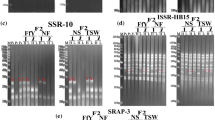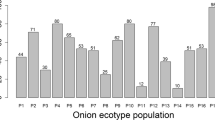Summary
One set of 285 genotypes from three landraces and one natural population and a second set of 165 genotypes from two landraces and one natural population were evaluated in separate trials. Variation among populations was mostly accounted for by the difference between landrace and natural population genotype groups, the former showing features related to higher seed yield and short-term aerial dry matter (DM) yield and to lower persistence, cold tolerance and protein content. Compared to variance among ecotypes, that within ecotypes was never lower and it was at least four-fold higher for important traits such as aerial and total (aerial plus stolon) DM yield, stolon density, production of seed heads and cold tolerance. Landraces and natural populations showed similar levels of intra-population variation for all traits except cold tolerance, for which landraces tended to somewhat greater variation. Trait associations were less definite at the genotype level than what previously found in terms of mean values of the ecotypes. This finding and the relatively high broad sense heritability which was observed for all components of DM and seed yield can support the breeding activity on this clover. The level of variation and of heritability found for protein content do not suggest the routine evaluation of this trait in breeding programmes.
Similar content being viewed by others
References
Annicchiarico P., 1993. Variation for dry matter yield, seed yield and other agronomic traits in Ladino white clover landraces and natural populations. Euphytica 71: 131–141.
Annicchiarico P., 1994. Produttività e distinguibilità di ecotipi e varietà di tipo ‘giganteum’, e caratteri utili per l'identificazione varietale in trifoglio bianco. Sementi Elette 40 (6): 7–13.
Annicchiarico P. & E. Piano, 1994. Interference effects in white clover genotypes grown as pure stands and binary mixtures with different grass species and varieties. Theor. Appl. Genet. 88: 153–158.
Berardo N., 1992. NIRS calibration for white clover. p. 104–106. In: R.A. Tylor (Ed.). Proc. Int. Diffuse Reflectance Conf. The Council for Near-Infrared Spectroscopy, Gaithersburg.
Burdon J.J., 1980. Intraspecific diversity in natural populations of Trifolium repens. J. Ecology 68: 717–735.
Caradus J.R. & A.C. MacKay, 1990. Breeding for increased stolon branching and node density in white clover. p. 347–348. Proc. XVI Int. Grassl. Congr. The French Grassland Society, Nice.
Caradus J.R. & D.R. Woodfield, 1990. Estimates of heritability for, and relationships between, root and shoot characters in white clover. I. Replicated clonal material. Euphytica 46: 203–209.
Caradus J.R., D.F. Chapman, A.C. MacKay & M.G. Lambert, 1990. Morphological variation among white clover (Trifolium repens L.) populations collected from a range of moist hill coutry habitats. N. Z. J. Agric. Res. 33: 607–614.
Elgersma A., G.D. Winkelhorst & A.P.M.den Nijs, 1994. The relationship between progeny seed yield in drilled plots and maternal spaced-plant traits in perennial ryegrass (Lolium perenne L.). Plant Breeding 112: 209–214.
Frame J. & P. Newbould, 1986. Agronomy of white clover. Adv. Agron. 40: 1–88.
Freund R.J., R.C. Littell & P.C. Spector, 1986. SAS System for linear models. SAS Institute, Cary.
Gibson P.B., 1957. Effect of flowering on the persistence of white clover. Agron. J. 49: 213–215.
Hayward M.D., 1983. Selection for yield in Lolium perenne L. Selection and performance under spaced plant conditions. Euphytica 32: 85–95.
Knight W.E., 1953. Interrelationships of some morphological and physiological characteristics of Ladino clover. Agron. J. 45: 197–199.
Norris I.B., 1990. The inheritance of the cold induction response with respect to floral initiation in white clover (Trifolium repens L.). Euphytica 47: 159–164.
Piano, E. & P. Annicchiarico, 1995. Persistence of Ladino white clover ecotypes and its relationship with other agronomic traits. Grass Forage Sci. (in press).
Rhodes I., 1991. Progress in white clover breeding. p. 1–9. In: White clover development in Europe. F.A.O., Rome.
Rhodes I. & W. Harris, 1979. The nature and basis of differences in sward composition and yield in ryegrass—white clover mixtures. Brit. Grassl. Soc. Occ. Symp. 10: 55–60.
Rhodes I. & K.J. Webb, 1993. Improvement of white clover. Outlook on Agric. 22: 189–194.
Ronningen T.S., 1953. Susceptibility to winter injury and some other characteristics in Ladino and common white clovers. Agron. J. 45: 114–117.
Rotili P., 1975. Principaux aspects d'une méthode de sélection de la luzerne basée sur des dispositifs qui utilisent la concurrence entre les plantes. Ann. Amélior Plantes 25: 29–49.
Rowe D.E. & G.E. Brink, 1993. Heritabilities and genetic correlations of white clover clones grown in three environments. Crop Sci. 33: 1149–1152.
Smith D., 1949. Differential survival of Ladino and common white clover encased in ice. Agron. J. 41: 230–234.
Van Bockstaele E.J. & G. Rijckaert, 1988. Potential and actual seed yield of white clover varieties. Plant Varieties and Seeds 1: 159–169.
Van Bogaert G., 1977. Factors affecting seed yield in white clover. Euphytica 26: 233–239.
Williams W.M., 1983. Exploitation of genetic resource through breeding: Trifolium repens. p. 261–274. In: J.G. McIvor & R.A. Bray (Eds.) Genetic Resources of Forage Plants. CSIRO, Melbourne.
Williams W.M., 1987a. Adaptive variation. p. 299–321. In: M.J. Baker & W.M. Williams (Eds). White clover. C.A.B. International, Wallingford.
Williams W.M., 1987b. Genetics and breeding. p. 343–419. In: M.J. Baker & W.M. Williams (Eds). White clover. C.A.B. International, Wallingford.
Woodfield D.R. & J.R. Caradus, 1990. Estimates of heritability for, and relationships between, root and shoot characters of white clover II. Regression of progeny on mid-paren. Euphytica 46: 211–215.
Woodfield D.R. & J.R. Caradus, 1994. Genetic improvement in white clover representing six decades of plant breeding. Crop Sci. 34: 1205–1213.
Author information
Authors and Affiliations
Rights and permissions
About this article
Cite this article
Annicchiarico, P., Piano, E. Variation within and among Ladino white clover ecotypes for agronomic traits. Euphytica 86, 135–142 (1995). https://doi.org/10.1007/BF00022019
Received:
Accepted:
Issue Date:
DOI: https://doi.org/10.1007/BF00022019




